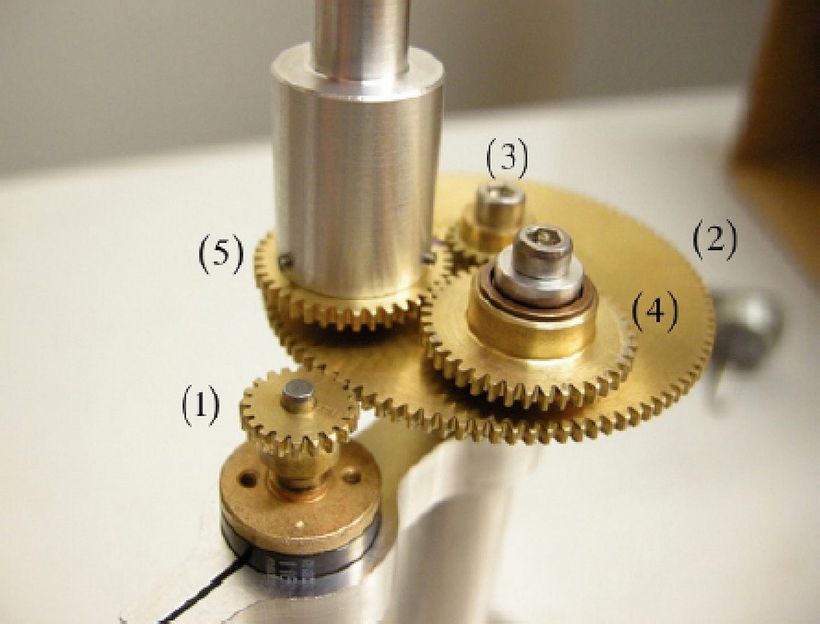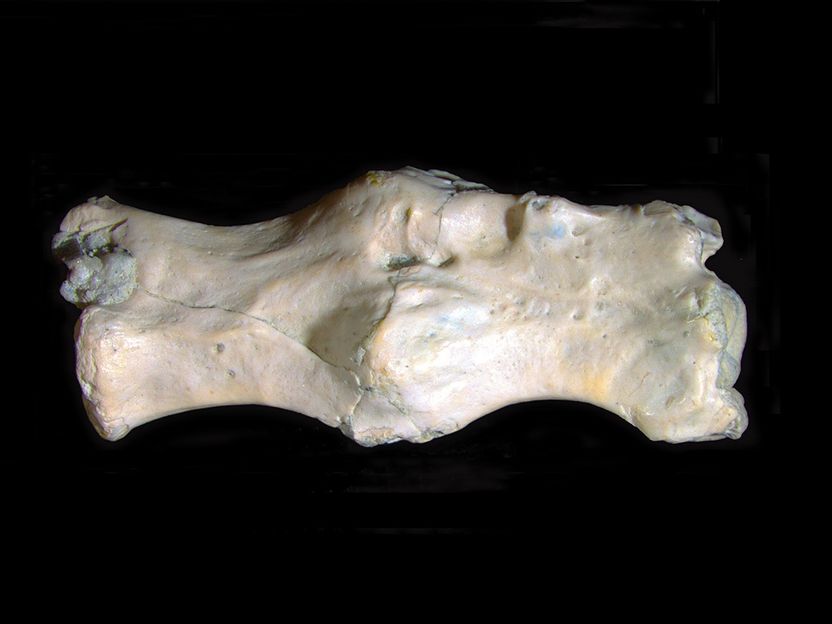New tool for studying magnetic, self-propelled bacteria that resemble compass needles
To better understand the behavior of the microbial world's magnetotactic bacteria three researchers have developed a new tool that allows these unique microscopic species to be studied more easily, especially in their natural environment.

This is a rotating permanent magnet tool developed by Smid et al for viewing magnetotactic bacteria with a light microscope. A first gear (1) is mounted on a motor to drive a larger gear (2). The second gear rotates around a fixed axis on which a third gear (3) is mounted. A fourth gear (4) is designed to change the direction of rotation of the fifth gear (5), upon which the permanent magnet is attached.
Pieter Smid/Ludwig-Maximilians-Universität
Magnetotactic bacteria can be found in both freshwater and marine environments. What makes them magnetic is that they produce chains of organelles called magnetosomes that contain nanometer-size iron crystals. The earth's magnetic field puts a torque on the magnetosome chains, rotating the bacteria in which they reside. This causes the bacteria to swim in the direction of the applied external force.
"In other words, magnetotactic bacteria act as self-propelled compass needles," said Pieter Smid, a geophysicist with Ludwig-Maximilians-Universität in Munich, Germany and the University of Nottingham in the United Kingdom. "Their magnetic abilities help them find a chemically suitable habitat in which to thrive."
Smid said that magnetotactic bacteria are important creatures to study because they can provide scientific insight into how our planet's sedimentary layers were formed. "When these microbes die in aqueous sediments, their magnetosomes are conserved in the rocks formed from that sediment," he explained. "The magnetic properties are permanently imparted to the rock which, in turn, serves as a record of changes in the earth's magnetic fields and provides us with a timeline for the rock's creation."
Making Study of Magnetotactic Bacteria More "Attractive"
"In the past, two pairs of electromagnetic coils were wrapped around a microscope to control the swimming direction of the magnetotactic bacteria," Smid said. "These multicomponent systems required large power supplies, complex electromagnetic frameworks, much electronic circuitry and control software -- not the kind of mechanism that's suitable for outside-the-lab experiments."
Conventional magnets also produced magnetic fields that were difficult to control, with waves of varying intensities filling the microscope viewing area. Such variations, Smid said, often played havoc with measurements being performed on samples of magnetotactic bacteria.
Smid and colleagues solved these problems by designing a simple mechanism using a single rotating permanent magnet. Their device resembles the inner workings of a watch, with the magnet positioned atop a concentric series of five gears turning in sync to create a strictly controlled and easily manipulated rotating magnetic field.
"The permanent magnet in our mechanism moves along a circular trajectory while rotating around its dipole axis," Smid said. "As the magnet turns, it generates a magnetic field of constant amplitude and when we place this next to a microscope, it drives the magnetotactic bacteria on the scope to swim in a circular motion and keeps them in view."
By measuring the radius of each circle the magnetotactic bacteria travel as the magnet rotates faster and faster, the researchers can accurately determine swimming speed. This is a key to better understanding how the bacteria move in a magnetic field and how those dynamics might be used in future applications.
When the frequency of the magnetic field rotation increases to the point that the bacteria will no longer follow the generated field, they break out of their circular swimming pattern. "This specific frequency, known as the 'escape frequency,' can be used to calculate a bacterium's magnetic moment -- the measure of its ability to align with a magnetic field," Smid explained.
Simple System, Many Advantages
The success of the simple concentric rotating magnet device was unexpected, Smid said. "We didn't believe that we could produce a rotating magnetic field of constant amplitude, but the results showed that our system does what conventional electromagnets can do with less equipment, lower cost and most importantly, more flexibility, since it can be adapted to many light microscopes and taken into the field," he said.






















































